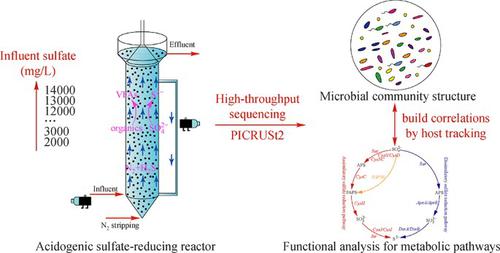Frontiers of Environmental Science & Engineering ( IF 6.1 ) Pub Date : 2021-08-15 , DOI: 10.1007/s11783-021-1481-8 Jun Li 1 , Aimin Li 1 , Minhui Cai 1 , Gan Luo 1 , Yaping Wu 1 , Yechao Tian 1 , Liqun Xing 1 , Quanxing Zhang 1 , Yan Li 2

|
For comprehensive insights into the influences of sulfate on performance, microbial community and metabolic pathways in the acidification phase of a two-phase anaerobic system, a laboratory-scale acidogenic bioreactor was continuously operated to treat wastewater with elevated sulfate concentrations from 2000 to 14000 mg/L. The results showed that the acidogenic bioreactor could achieve sulfate reduction efficiency of greater than 70% for influent sulfate content less than 12000 mg/L. Increased sulfate induced the accumulation of volatile fatty acids (VFAs), especially propionate and butyrate, which was the primary negative effects to system performance under the high-sulfate environment. High-throughput sequencing coupled with PICRUSt2 uncovered that the accumulation of VFAs was triggered by the decreasing of genes encoding short-chain acyl-CoA dehydrogenase (EC: 1.3.8.1), regulating the transformation of propanoyl-CoA to propenoyl-CoA and butanoyl-CoA to crotonyl-CoA of propionate and butyrate oxidation pathways, which made these two process hardly proceed. Besides, genes encoding (EC: 1.3.8.1) were mainly carried by order Clostridiales. Desulfovibrio was the most abundant sulfate-reducing bacteria and identified as the primary host of dissimilatory sulfate reduction functional genes. Functional analysis indicated the dissimilatory sulfate reduction process predominated under a low sulfate environment, but was not favored under the circumstance of high-sulfate. With the increase of sulfate, the assimilatory sulfate reduction process finally overwhelmed dissimilatory as the dominant sulfate reduction pathway in acidogenic bioreactor.
中文翻译:

PICRUSt2 功能预测产酸生物反应器中的有机化合物降解和硫酸盐还原途径
为了全面了解硫酸盐对两相厌氧系统酸化阶段性能、微生物群落和代谢途径的影响,连续运行实验室规模的产酸生物反应器来处理硫酸盐浓度从 2000 到 14000 毫克/ L。结果表明,产酸生物反应器在进水硫酸盐含量低于12000mg/L的情况下,硫酸盐还原效率可达到70%以上。增加的硫酸盐会导致挥发性脂肪酸 (VFA) 的积累,尤其是丙酸盐和丁酸盐,这是高硫酸盐环境下对系统性能的主要负面影响。结合 PICRUSt2 的高通量测序发现 VFA 的积累是由编码短链酰基辅酶 A 脱氢酶 (EC: 1.3.8.1) 的基因减少引发的,调节丙酰辅酶 A 向丙烯酰辅酶 A 和丁酰辅酶 A 的转化CoA 转化为丙酸和丁酸氧化途径的巴豆酰-CoA,这使得这两个过程难以进行。此外,编码基因(EC:1.3.8.1)主要由梭菌目携带。脱硫弧菌是最丰富的硫酸盐还原细菌,被确定为异化硫酸盐还原功能基因的主要宿主。泛函分析表明,在低硫酸盐环境下,异化硫酸盐还原过程占主导地位,而在高硫酸盐环境下不利于异化硫酸盐还原过程。随着硫酸盐的增加,同化硫酸盐还原过程最终压倒异化,成为产酸生物反应器中主要的硫酸盐还原途径。











































 京公网安备 11010802027423号
京公网安备 11010802027423号